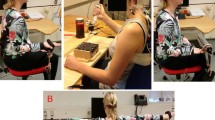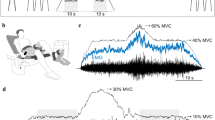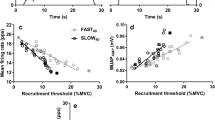Abstract
To test the hypothesis that phasic muscle activation is related to the acceleration-deceleration characteristics of the resulting movement, we examined the relation between the duration of the acceleratory phase of a variety of movement types and the duration of the phasic muscle activity producing the acceleration (the initial agonist burst, AG1). Movements of five types were studied: (1) step-tracking movements of different amplitudes (10–90 deg) and durations (200–800 ms), (2) movements of the same amplitude (40 deg) and duration (600 ms) varying only in their symmetry ratio (SR, ratio of acceleration to deceleration durations), (3) movements in which acceleration duration was changed while acceleration magnitude was held constant, (4) oscillatory movements of different frequencies and peak amplitudes, (5) step-tracking movements against different inertial loads. Subjects made movements about the elbow joint in the horizontal plane. Surface electromyographic (EMG) activity was recorded from the biceps and the lateral head of the triceps muscles. Under all movement conditions tested and with acceleration duration ranging from 100 to 500 ms, acceleration duration varied linearly with the duration of AG1. Correlation coefficients for the linear regression lines ranged from 0.8 to 0.99. The slope of the best fit linear regression lines ranged from 0.5 to 1.6 and tended to be higher for extensions than flexions. The variations in slope may arise from differing mechanical properties of the biceps and triceps muscles, as well as from active forces produced in the antagonist. AG1 duration was unchanged by inertial loading when subjects kept acceleration duration constant. If subjects responded to an increase in inertial load with an increase in acceleration duration, there was a corresponding increase in AG1 duration. The data demonstrate a general relation between one characteristic of muscle activation (AG1 duration) and the resulting movement. The linear form of the relation is invariant across movement amplitude (range 10–90 deg), speed, duration (range 200–800 ms) and temporal profile (SR range 0.3-2.7), and is also independent of movement type (step, oscillatory). Such a general and simple relation between EMG and movement suggests that, at least to a first approximation, the nervous system can rather simply determine the muscle activation patterns needed to produce movements with desired characteristics.
Similar content being viewed by others
References
Angel RW (1974) Electromyography during voluntary movement: the two-burst pattern. Electroencephalogr Clin Neurophysiol 36:493–498
Benecke R, Meinck HM, Conrad B (1985) Rapid goal directed elbow flexion movements: limitations of the speed control system due to neural constraints. Exp Brain Res 59:470–477
Berardelli A, Rothwell JC, Day BL, Kachi T, Marsden DC (1984) Duration of the first agonist EMG burst in ballistic arm movements. Brain Res 304:183–187
Brown SH, Cooke JD (1981) Amplitude- and instruction-dependent modulation of movement-related electromyogram activity in humans. J Physiol (Lond) 316:97–107
Brown SH, Cooke JD (1984) Initial agonist burst duration depends on movement amplitude. Exp Brain Res 55:523–527
Brown SH, Cooke JD (1986) Movement related EMG activity compensates for position dependent changes in limb properties. J Hum Mov Stud 12:297–312
Brown SH, Cooke JD (1990) Movement-related phasic muscle activation. I. Relations with temporal profile of movement. J Neurophysiol 63:455–464
Cooke JD, Brown SH (1986) Phase plane trajectory tracking: a new way of shaping movements. Brain Res Bull 16:435–437
Cooke JD, Brown SH (1989) EMG acceleration relations across a variety of movements. Soc Neurosci Abstr 15:4733
Cooke JD, Brown SH (1990) Movement-related phasic muscle activation. II. Generation and functional role of the triphasic pattern. J Neurophysiol 63:465–472
Corcos DM, Gottlieb GL, Agarwal GC (1989) Organizing principles for single-joint movements. II. A speed-sensitive strategy. J Neurophysiol 62:358–368
Ghez C, Gordon J (1987) Trajectory control in targeted force impulses. I. Role of opposing muscles. Exp Brain Res 67:225–240
Gordon J, Ghez C (1984) EMG patterns in antagonistic muscles during isometric contraction in man: relations to response dynamics. Exp Brain Res 55:167–171
Gottlieb GL, Corcos DM, Agarwal GC (1989) Organizing principles for single-joint movements. I. A speed-insensitive strategy. J Neurophysiol 62:342–357
Hallett M, Marsden CD (1979) Ballistic flexion movements of the human thumb. J Physiol (Lond) 294:33–50
Hallett M, Shahani BT, Young RR (1975) EMG analysis of stereotyped voluntary movements in man. J Neurol Neurosurg Psychiatry 38:1154–1162
Hoffman DS, Strick PL (1990) Step-tracking movements of the wrist in humans. II. EMG analysis. J Neurosci 10:142–152
Karst GM, Hasan Z (1987) Antagonist muscle activity during human forearm movements under varying kinematic and loading conditions. Exp Brain Res 67:391–401
Lestienne F (1979) Effects of inertial loading and velocity on the braking process of voluntary limb movements. Exp Brain Res 35:407–418
Marsden CD, Obeso J, Rothwell JC (1983) The function of the antagonist muscle during fast limb movements in man. J Physiol (Lond) 335:1–13
Mustard BE, Lee RG (1987) Relationship between EMG patterns and kinematic properties for flexion movements at the human wrist. Exp Brain Res 66:247–256
Nelson WL (1983) Physical principles for economies of skilled movements. Biol Cybern 46:135–147
Ostry DJ, Cooke JD, Munhall KG (1987) Velocity curves of human arm and speech movements. Exp Brain Res 68:37–46
Schmidt RA, Sherwood DE, Walter CB (1988) Rapid movements with reversals in direction. I. The control of movement time. Exp Brain Res 69:344–354
Sherwood DE, Schmidt RA, Walter CB (1988) Rapid movements with reversals in direction. II. Control of movement amplitude and inertial load. Exp Brain Res 69:355–367
Wacholder K, Altenburger H (1926) Beiträge zur Physiologie der willkürlichen Bewegung. X. Einzelbewegungen. Pflugers Arch 214:642–661
Wadman WJ, Denier van der Gon JJ, Gekuze RH, Mol CR (1979) Control of fast goal-directed arm movements. J Hum Mov Stud 5:3–17
Wallace GK (1989) The control of oscillatory movements of the forearm. Biol Cybern 61:233–240
Author information
Authors and Affiliations
Rights and permissions
About this article
Cite this article
Cooke, J.D., Brown, S.H. Movement-related phasic muscle activation. Exp Brain Res 99, 473–482 (1994). https://doi.org/10.1007/BF00228984
Received:
Accepted:
Issue Date:
DOI: https://doi.org/10.1007/BF00228984




